Saccade Strategy in Alternating Exotropia
- PMID: 34866747
- PMCID: PMC8641942
- DOI: 10.11476/shinkeiganka.37.196
Saccade Strategy in Alternating Exotropia
Abstract
Patient with exotropia frequently alternate fixation, looking at something with one eye and then switching their attention to acquire a new target with the other eye. Which eye informs the brain about the location of the new target? To address this issue, we presented targets dichoptically to 16 exotropes that were visible to the fixating eye, the deviated eye, or to both eyes. We then compared the subjects' choice of eye for target acquisition with the organization of their suppression scotomas. There was a correspondence between suppression scotoma maps and the eye used to acquire peripheral targets. In other words, a target perceived via an eye was also fixated by it. These studies reveal how patients with alternating strabismus, despite eye misalignment, manage to localize and fixate efficiently visual targets in their environment.
Keywords: diplopia; eye fixation preference; ocular dominance; scotoma; suppression.
Conflict of interest statement
Conflict of interest: Yes
Figures





References
-
- von Gräfe A: Über das Doppelsehen nach Schieloperationen und Incongruenz der Netzhaute. Arch fiir Ophthalmol 1: 82–120, 1854
-
- Herzau V: Untersuchungen über das binokulare Gesichtsfeld Schielender. Doc Ophthalmol 49: 221–284, 1980 - PubMed
-
- Joosse MV, Simonsz HJ, et al.: Quantitative visual fields under binocular viewing conditions in primary and consecutive divergent strabismus. Graefes Arch Clin Exp Ophthalmol 237: 535–545, 1999 - PubMed
-
- Serrano-Pedraza I, Manjunath V, et al.: Visual suppression in intermittent exotropia during binocular alignment. Invest Ophthalmol Vis Sci 52: 2352–2364, 2011 - PubMed
Grants and funding
LinkOut - more resources
Full Text Sources
